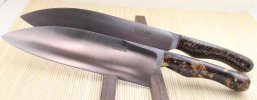My experience is that - The better looking the wood, the more you have to deal with defects.
What makes burl happen is twisting and stresses, or tumors. The sheer weight of a large tree can cause the root ball to start to twist.
What makes spalt happen is a fungus, AKA - rot. Leave a pretty curly maple log on the ground in the forest after it dies and falls, and get spalted maple. ( leave it a bit longer and you get rotted wood)
What makes the colors in many woods is all sorts of things, often a combo of several extremes.
Some wood has to be heated or steamed to get pretty. Others have to be left on the ground for a year or more.
None of these things are conducive to straight and tight grain. You will get eyes, voids, soft spots,....sometimes completely rotted wood.....in any promising piece of material. The stabilization will make them resist soaking up more moisture, and in some stabilization methods, can make the soft woods much harder ( buckeye burl for one), but the "defects" that make the wood beautiful will also make it more challenging to use.
A large bottle of thin CA and a smaller bottle of medium CA are a requisite for getting a good finish on these woods.
Once you get the handle about 90% shaped, start applying the CA and then immediately sanding. You MUST wear a respirator and face shield doing this, as the vapors are pretty annoying. I use an external air source hood for these tasks, as the whole shop can make your eyes burn when grinding wet CA. Bigger holes can be filled with medium CA and have sanding dust from earlier sanding packed into the resin while still wet. Once the dust is packed tight and sanded lightly, flood with thin CA and continue as before. (TIP - Place a cookie sheet under the grinder for a minute to collect some dust on any project that may need filling. Put the dust in a zip-loc bag and label the wood type.)
Keep sanding in the grinding dust as you apply more CA and the cracks/holes,/punk/etc. will all seal up and become solid with the wood. It will then sand and polish very well. Repeat as needed if new places show up.
When the handle gets shaped to the final dimensions, give it a complete flooding with CA and let it dry. Repeat as needed until no more will absorb. Then sand to the final finish.
I had a batch of extreme old growth redwood stabilized, and as expected, the twisting grain pulled apart a bit throughout the blocks. This leaves "splits" and "voids"in the lovely wood. Someone said that it was a shame it was all ruined. I showed him a handle with the same wood finished as abover with CA and he could not believe how curly and full of eyes it was. All the fill areas and features become darker lines and dots.

